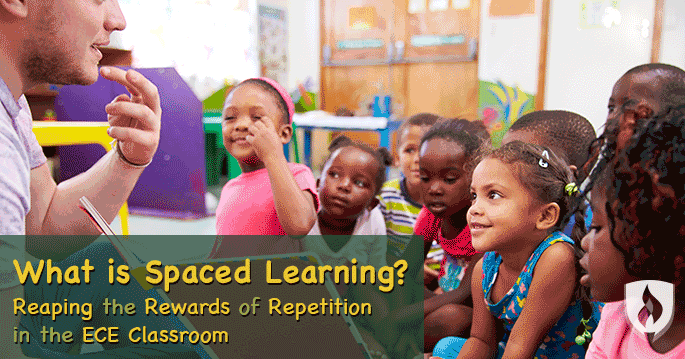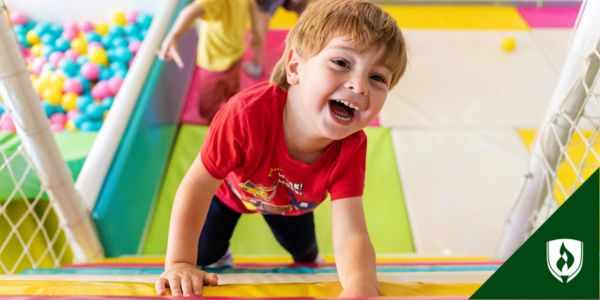What Is Spaced Learning? Reaping the Rewards of Repetition in the ECE Classroom
By Ashley Brooks on 10/21/2016

When most people think of preschool, they probably envision a colorful room full of tiny chairs and tables, with little ones scrambling to build block towers, paint masterpieces and play dress up. To the untrained eye, your ECE classroom may look like one big playroom. But just because kids are having fun doesn’t mean they aren’t learning!
Your preschool classroom is a place where children are introduced to early learning concepts like literacy, counting and spatial reasoning. You probably aren’t using worksheets and flash cards to drill your lessons, but the early literacy and STEM exposure you provide in your classroom is invaluable to the students’ success later on. They key is helping them absorb as many early concepts as they can. Thanks to a technique called spaced learning, that priority is now easier to accomplish.
Spaced learning uses repetition to help even the littlest learners remember the facts and ideas that are introduced each day in your classroom. Want to give spaced learning a try in your ECE classroom? Read on to learn how you can put this learning technique to use!
What is spaced learning?
Have you ever been told something early in the day and by dinnertime you can’t remember it for the life of you? That’s because when you learn something once, it gets stored in short-term memory. But if you learn a concept repeatedly, it sticks in your long-term memory.
The spaced learning method capitalizes on this by repeatedly presenting new information to students in different ways, with short breaks between learning sessions. “The idea behind spaced learning is introducing the same concept three times,” explains Katya Seberson, reading coach at Executive Mind.
Each of these three introductions is called an input. Each input is separated by a 10-minute break in which students do an unrelated activity. The method was introduced by teachers at Monkseaton High School. They recommend presenting new information in the first input, focusing on recall during the second input and asking students to show their understanding of the concept during the third input.
It’s easy to see how spaced learning can apply to high school or college students, but it’s also proven effective at teaching people about topics as diverse as music theory and tips for using their iPhones! Spaced learning can also be a helpful tool in your arsenal as an ECE teacher.
How can I use spaced learning in my ECE classroom?
Spaced learning will look different in your classroom than it would in a high school, but you can still apply the basic technique with your young learners.
The biggest adjustment to making spaced learning work for your students is to alter the timing of input lessons and the breaks in between. Young learners probably won’t have the patience for a long, lecture-type lesson. But by keeping input lessons short and giving ample time for breaks, you can tailor the spaced learning lesson.
Here’s an example of how the three phases of spaced learning could look in your ECE classroom.
1. Expose kids to new ideas
The first phase of spaced learning is all about introducing a new idea. Seberson says she uses this time to explain the concept or do a demo showing students how something works.
In your classroom, this may look like pointing out different shapes or colors during morning circle time, or showing children how you use a scissors or count items. You could also read a book related to the idea you want to introduce and talk about it with children afterwards.
2. Use games and activities to reinforce learning
The second input focuses on recalling the new information you introduced earlier in the day. Remember that young learners don’t do well with rote repetition, so you might have to get creative.
“I find a way to practice the concept in a game or exercise,” Seberson says. Invite children to play a game or spend time on an activity that incorporates the ideas introduced during the first input.
You might ask kids to draw a certain shape, go on a scavenger hunt to find items of a certain color or count how many times they’re able to hop on one foot. Try not to worry too much about whether or not kids get it “right.” The continual exposure is what helps them learn, so simply engaging in the activity reinforces the new information.
3. Let kids be the teachers
The last input of spaced learning asks students to demonstrate their understanding of the topic they just learned. One of the best ways for young kids to do this is to become the teachers themselves!
Seberson asks her students to teach a concept back to her or to the other students in the class. “They get to wear the teacher’s hat and verify their own understanding of the concept.” She also encourages kids to continue playing teacher at home by teaching their parents or stuffed animals what they’ve learned.
Kids may have forgotten a bit of information by the time their parents pick them up, so this gives them the chance to practice even more reinforced, repetitive learning at home.
4. Leave plenty of time for play
The reason spaced learning is so effective is the combination of repetition and breaks between learning sessions. The length of the gap between each input is actually more important than the length of the lesson itself! Make sure you leave plenty of time for kids to enjoy free play in between learning inputs.
The best activities during these breaks are the types of things kids are drawn to naturally, like playing with clay, coloring or playing games that require hand-eye coordination. These types of activities allow kids to focus on something other than the lesson, which improves the chances of the memory pathway being allowed to “rest” and form stronger connections.
Start reaping the rewards in your classroom
The science behind spaced learning makes this teaching method a game changer for students—even the little ones in your preschool classroom! Check out our article for other ideas about how to conduct your classroom: 7 Teaching Strategies to Consider for Your ECE Classroom!.
RELATED ARTICLES:




